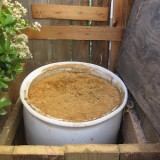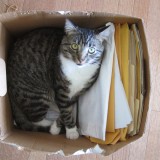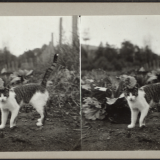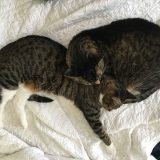 |
| View up the side yard, looking toward the back yard. The new bin is all pretty and shiny. |
Mrs. Homegrown here:
I posted about cat litter composting a while back, and got lots of interesting comments and suggestions. If you’re researching the topic, I suggest you check out that post, the comments especially.
Since then, Erik and I have decided on the method we’re going to try. We’re just going to do straight up, classic composting, Humanure Handbook style. The only difference between this style and ordinary composting is that we’ll let this compost rest for two years before we spread it, to be sure the bad beasties die off. And in case they aren’t gone, we won’t spread the finished compost around edible plants.
No, this is not orthodox practice. It is not considered “safe” to compost pet waste–all the standard advice tells you not to– but we’re doing it anyway, because we trust time and bacteria and worms and our own composting skills to make good compost out of cat litter. Also, the standard advice is mostly in reference to a home’s one-and-only compost pile. You would not want to add cat or dog poop to your regular compost pile. It needs to be kept in a separate pile that is managed more carefully.
The biggest challenge in this scheme for us was figuring out where to put yet another compost container. Our yard is already overrun with barrels and bins. Worse, when we thought it through, we realized we needed room for not just one compost bin, but at least two, maybe three, because of the aging issue.You know, fill one up, set it aside, start on another. The barrels pile up!
The solution is our south-facing side yard. That “yard” is a 3 foot wide strip of sun-baked soil that no one ever sees. It’s divided from our neighbor’s side yard (also rarely used) by a hedge of tenacious jade plants. There is no access to the back yard from the side yard. It has been a wasteland for all the time we’ve been here. This year Erik put in two tiny raised planters there to see if he could grow hops on the side of the house. But it is still mostly unused, invisible space–perfect for compost bins.
The only problem was access. It’s an awkward hike around the front house to get to that side yard. It would be no fun to have haul the dirty litter over there. This is where Erik’s genius came to play. He decided to cut a hole in our back yard fence–a little section of fence convenient to our back porch– and make a small door that will let us dump the litter directly into the barrel, which sits on the opposite side of the fence. We’re already calling this the Cat Poop Portal ™.
 |
| The Portal from the back yard, looking down on the drum |
The specs:
- We’re composting in a food grade plastic 55 gallon drum, which we found on Craigslist. It once held brown rice syrup. I prefer to use food grade plastics for compost, especially since we’re dealing with used barrels. Better food residue than chemical residue.
- Our drum is white because white was all that was available. I’ve heard white degrades more quickly than the blue or black. Don’t know if that is true, but I have also heard that the lifespan of the drum can be extended by painting or covering it with a tarp. We may do one of those things.
- Erik sawed off the top of the drum, because it wasn’t the type with a screw off lid. Rather it had a bung hole configuration. (I’m still trying to become blase about tossing around the term bung hole.) This means we don’t have a lid. We’ll just put a piece of cardboard or wood on top, because we’re classy like that.
- We drilled lots of 1/2″ air holes in the drum, on the sides and bottom, for air flow.
- We put a thick layer of straw at the bottom, before we added the first deposit of litter, to provide a little ventilation from the bottom. The barrel is sitting on soil, to allow worms and bugs access.
- Once the straw was down, we added our accumulated litter. (Yep, that’s right, I’ve been saving my cat box cleanings just this occasion. Waste not want not!) See my thoughts below regarding types of cat litter. Then we wet down the litter really well, and covered it with a topping of clean straw, and topped the drum with a piece of wood. Let the decomposition begin!
- Note: Never place a place a poop-filled compost bin near vegetable beds, due to the possibility of bad bacteria leaching through the soil. Ours is remote from anything edible.
 |
| The holes inside the 55 gallon drum |
Thoughts on the composting:
As I said at the beginning, this is pretty much straight up, normal composting, with the exception of a long aging period at the end. The Humanure Handbook is a good general guide to composting principles as well having special instructions regarding the safe handling of poop. If you don’t know how to compost, I’d start there. That book is widely available, and they have a free pdf on their website. See our resources tab.
Our cat litter is compostable–we’ve been using both Feline Pine and Yesterdays News–pine and paper, respectively. Compostable litter is made up of a true carbon source–that means plant-based material: corn, wheat, paper and sawdust are all okay. Clay litter, or anything with chemicals in it, would not be appropriate for this. Clay is not toxic, it’s just that it wouldn’t ever break down into proper compost. I don’t know what the clumping kind is made of, so I avoid it–but if your clumping kind is made of unadulterated carbon material, by all means compost it. Litter with baking soda added isn’t a good idea, because it’s salty. Soil does not love salt. I also avoid anything with added scent, because the chemicals used in fragrances are not something I want transferred to my soil.
We’ll soon find out what the carbon to nitrogen ratio is in the typical cat box. The litter is a heavy carbon source. We’ll see how it is balanced by the cat waste (nitrogen), but I suspect we’re going to have to add green stuff, like kitchen scraps, to get it to heat up and decompose. Here’s how we’ll know: if there’s too much carbon (litter), the pile will just sit there, cold and unchanging.
Another thing I predict is going to be problematic about this new cat bin is that we’ll be adding too little material, too slowly. This means it’s going to be very, very slow pile. Mass creates heat. The best piles are big piles. This might have to be addressed by bulking up the pile with material from another source.
My final concern is odor. This is within whiffing distance of both our patio and the neighbor’s window, so we don’t want any cat box miasma drifting around. Initial precautions include covering the surface of the pile with straw, and covering the top of the bin with a board. We’ll see how it goes.
Stay tuned for updates…






Ah, California. Tenacious JADE plants?! Here in New England, it’d be buckthorn or poison ivy. When I got a puppy I installed one of those in-the-ground bins (like a garbage can in the ground, with a lid. Holes so the composted material disperses into the soil) to toss poop. Not useful here when the snow flies (you’d think I’d have thought that through. Sigh.)
Your posts always come at the right time! DH and I have been talking about this, but didn’t really know where to start. Awesome!
I do have a litter recommendation for you. We’ve tried Feline Pine and Yesterdays News, and have found that they make it tough to scoop the clumps out, since they soak straight to the bottom. We just found Purr and Simple, which is great…clumps like clay, but made from coconut shell. 100% biodegradable. We love it…no more scraping the bottom of the box. Huzzah!
Anyways, great post. I’m going to go to Craigslist now and find a bung hole (hehehe) drum.
@Terry: CA is a strange place, a place where houseplants take over the world. I really don’t know how these jade plants survive with no water, baking in extreme temps…
@Sushi: Good tip on the litter! When you go to get a barrel, if you can find one with a screw off top, that’s even better that one with…uh…bung holes. With that kind you have to saw off the top.
u 2 r awsum!
I use cat country for my bunny, something about the wheat straw used in the compressed pellet really represses oders.. there is never that strong bunny urine smell in my house. Then again, offensive bunny odors in my opinion are not 1/4 as offensive as cat poop stink. : The litter isn’t exactly affordable though, I used to buy 40 lb bags in santa cruz for $15. They’re $30 here in LA!!
To add nitrogen…Save your pee to add to it.
I got a Pepsi syrup drum. The guy at the plant had to cut the top off since there was no way to get the top off, just a tiny hole in the top. It seems everything food-grade has no removable top.
I most certainly agree with the idea of no cat poop compost in the garden. But, since it is so bad, how harmful is it when you find a neighbor’s cat decided you built him a toilet (aka tilled or any loose soil)? Red pepper and screaming lots is my solution. Then, I worry about the food I am raising. Do you ever find evidence of cat visits in your food beds?
If you have black soldier flies in LA, they’ll find your bin and make short work of that cat poop. Yes siree!
I admire your intentions but I see what my cat eats, and well, I’d rather have him poop in the neighbors yard, instead of in a litter box where he should go then put it in a container to compost. But good going though!
The food-grade plastic might be a long-term problem.
I had a self-watering container built from reclaimed white food grade containers. In our L.A. sun it didn’t even last a year. When I went to move it after about 9 months in direct sun, the lip of the container came off in my hand, with long sharp splintery splits down the side of the entire container.
Moral: make sure the kitty kontainer is where you want it to be permanently (i.e. what happens regarding the Cat Poop Portal(tm) when you shift to aging barrel #1 and loading barrel #2 – you will no longer be able to move barrels).
Also when you eventually go to empty the barrels, be prepared for them to split seriously, and be prepared to pick plastic shards out of your compost.
I’m interested to see how this goes for you! When we were composting cat litter, we found it was way too dry to compost – but adding water made it smell like pee in too big a radius for our small yard.
Also, I envy you the portal/hidden area for the compost! Keep updating!
Yeehah! I am so inspired now. I am working at transitioning my 2 poop machines to compostable litter as I type. So far so good w/ the Feline Pine buried under the clumping clay they so like to kick everywhere. I hope they’ll be using nothing by compostable within a month.
One suggestion on the smell quotient in your collection barrel, if the straw isn’t sufficient, is those compressed wood shavings sold for small critters (which also work great as coop litter.) But also, as I am noting below, outside of ammonia fumes, smell might be due to what little cute nitrogen producer is eating, too.
I have to start working on phase two of my poop composting, and get the cats back on homemade food. Generally speaking, when they are eating meat I ground up myself, and then cooked, the poo doesn’t smell half as bad, and I hear it’ll break down a lot faster as well. This is all about what they’re able to digest completely, and commercial cat foods contain so much adjunct material in the way of veggies, starches, et al, that they tend to not digest all of it. I am coming to this stuff so late, having had cats much of my life.
Thought I’d mention a litter possibility I just came across:
http://www.tejascats.com/Wood%20Pellets/wood%20pellets.htm
Haven’t tried it though, but the price is right!
Regarding the smell issue, what you feed your cat has a lot to do with how their feces smells. When our cats are on their normal diet of 4 oz of meat per day (a combination of chicken, pork and beef, mostly chicken), their poop doesn’t smell at all.
We’ve had them on a high-end (95% protein) dry food for the last month or so, as we prepared to move across the country, and the difference is notable. However, it’s still not as bad as when they’ve been on lower quality wet foods in the past.
We recently had someone watching our cats while we were showing our old home for sale, and apparently she once tried to feed the canned food she feeds her own cats to ours, and the elder of our cats (they’re a mother-daughter pair), immediately tried to bury it in the litter box, because that’s what it smelled like to her. There is nothing worse that realizing that what you’re feeding your cat comes out the other end smelling exactly the same.
I spent a chunk of my morning reading about Toxoplasmosis Gondii. I’ve got access through my work library to medical research articles.
So far I’ve learned that cats are infected by eating cysts in infected meat. Rats are infected by the oocysts shed from cat poop. I’m still unclear on how that works. Rubbing their eyes with paws that have picked up the oocysts? Humans can be infected either way. It can and will infect any mammal. T gondii infections are dangerous to pregnant women and immunosuppresed people. Cats who get infected shed oocysts for 2-3 weeks and then won’t get infected again for another 6 years.
There aren’t easy soil tests for T Gondii oocysts. The T Gondii oocysts can live in water for 12-18 months, are not destroyed by chlorine or ozone exposure, but might treatable with UV radiation under controlled conditions. I haven’t found anything specific on how long they last in dry soil.
It’s also the same parasite that we’re supposed to cook pork thoroughly for. And it causes sheep to miscarry.
I thought trichinosis was the parasite in pork? Interesting.
One of the suggestions I found for cat poo composting, eons ago at the Humanure bulletin board, was to desiccate the feces before composting it.
and hey, I forgot to add, I’m really interested in how your composting goes. I was doing all that reading to figure out if it’s feasible since I’ve got 4 cats. I’ve been using sWheat scoopable litter and there’s got to be a better way than bagging & sending to the city dump.
And in regards to your previous post, cats are crepuscular, aka active at dawn and dusk. And having lived through kittenhood, I’ve sworn off any more kittens and will only take in old lazy cats from now on.
The best toy I’ve ever gotten that all my various cats have liked is a long strip of fleece at the end of a pole. Different cats will like different toys, but they all (for me) have loved that one.
@sara, I may have mis-interpreted all the articles I was reading. Although T. Gondii may be in addition to the trichinosis. I didn’t remember that word earlier today.
Thanks everyone for your comments and advice and toy ideas. We’ll be trying it all out!
Amazing post! I’m thinking of following your ideas, although it’ll be for dog poop instead. Thanks again for sharing!
@Joanne: I thought that might be the case, esp. because it’s in full sun. We’ll cover it. Make some pretty tarp skirt for it or something. You know, we’ve heard of people stuccoing barrels! Not a bad idea, really, as long as you never want to move it.
@SushiQ – I did some research about the Purr and Simple product. It isn’t coconut shells – it’s walnut shells from a grove in California which raised the nuts and came up with this as a byproduct! I emailed them and found the product should be safe for gardens (once the poop is composted) and have no harmful degradation products even from the clumping variety! I’m going to try it out!
@Mrs. Homegrown – Hi, from Tacoma! I’m a friend of Johnnie (Humanure Hero) from Vashon and met you on the book tour! Thanks for this great post. I’m trying it with the Purr and Simple clumping formula. I’ll let you know how it turns out. (Love the Cat Poop Portal (TM) name!)
Do you think soldier fly larvae would help speed up the composting process?
@Aliza: We haven’t done the soldier fly thing yet, so can’t comment ourselves, but an anon comment above seems to indicate that they’d help.
@Sushi and @Patricia: I’d think walnut shell litter would be slow to break down in the pile. Everything organic breaks down eventually, of course, but walnut shells are xtra tough. I’d guess they’d need a lot of moisture and heat–but who knows? Let us know how your compost experiments go. I’d definitely like to use a compostable clumping litter.
I’d be wary of anything with walnut shells as black walnuts produce juglone which can kill many plants. you wouldn’t want your compost to be an herbicide!
@Lynette: That’s a good point. I’m not sure if the shells themselves are all that herbacidal…still..
We did a similar experiment two years ago … just recently put the resulting compost under some ornamental bushes. We use Good Mews cat litter, which is a local product that is basically recycled newspaper pressed into pellets. Everything was composted in a one of those rotating black composters, with some yard waste thrown in. IMO, the mix could have used a lot more brown material, maybe a nice chunk of wet leaves, for the following problems:
(a) The first few weeks the barrel really smelled like ammonia, a dead giveaway that there was too much N. Cat pee is apparently >>> newspaper pellets in the C/N department.
(b) After two years sitting around, the end product was GRAY. It looked good in every other way: lots of worms, no poop, earthy smell, nice crumbly texture. If you stuck your hand in it it would feel just like regular compost. But it still looked like wet pulverized cat litter, not dirt. It sounds obvious putting it in writing, but if you want to end product to be brown, at least some of the carbon going in needs to be brown.
It’s too bad polyethylene is so very, very difficult to paint.
Covering it in soot might be the way to go.
As to hot compost: if it’s nitrogen-poor, maybe letting a full barrel accumulate before adding nitrogen would be the way to go. I also suspect it will be overly dry, and unpleasant to turn. Perhaps the way to get it going, once it’s full, is to add urine.
How is the cat litter composting going?
@Nancy: You’re right–it’s time for an update! I’ll do it in the form of a post, rather than here. But in short, it works but there’s still stuff to figure out.